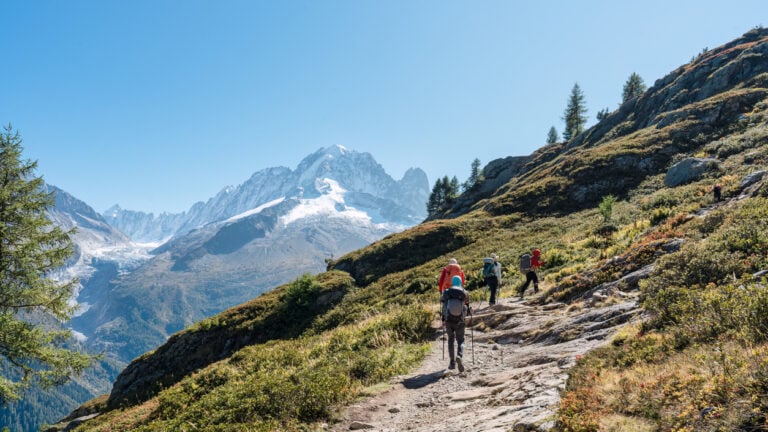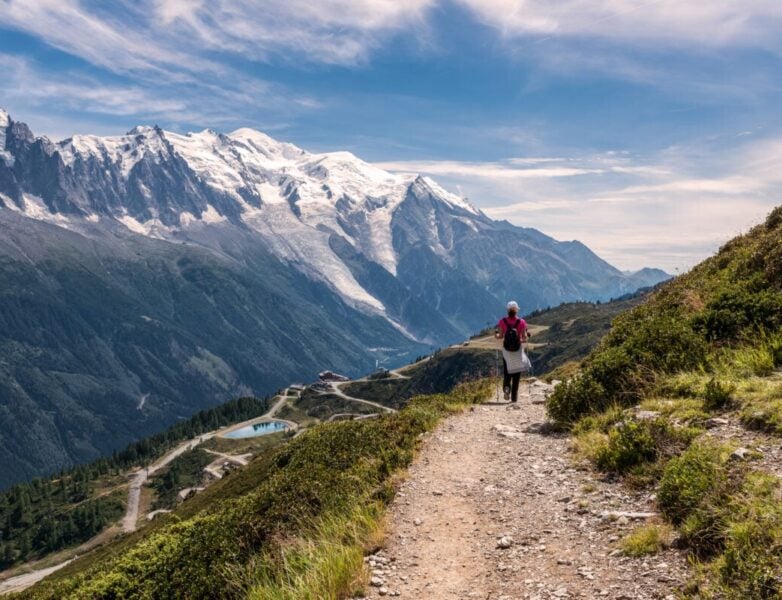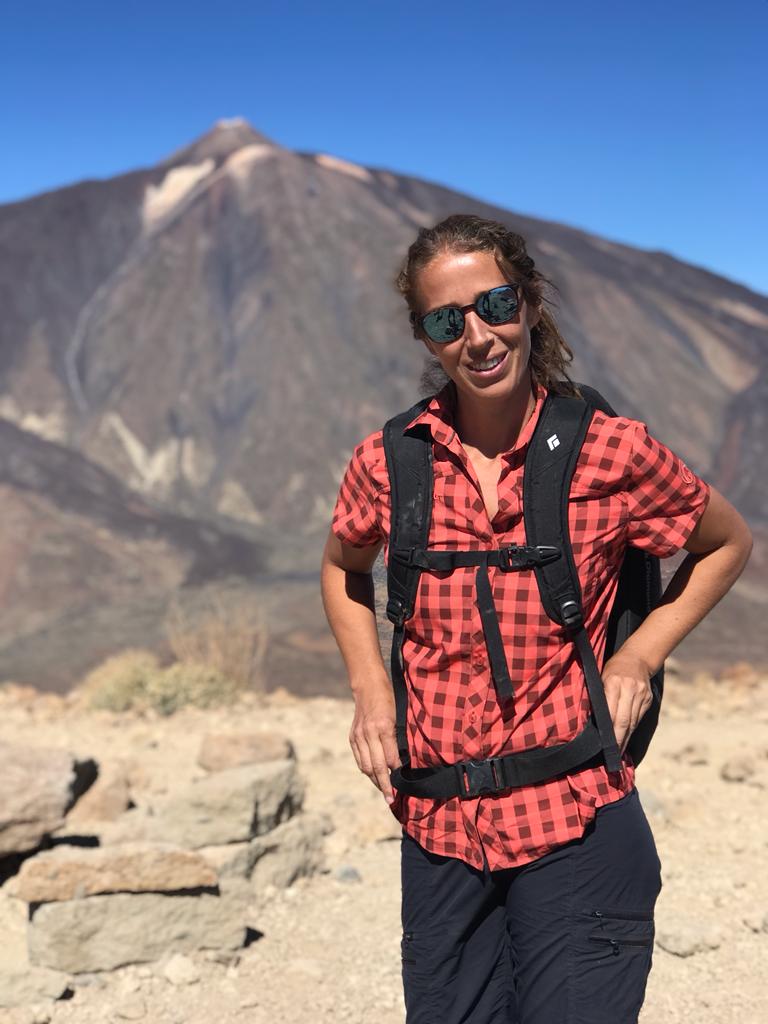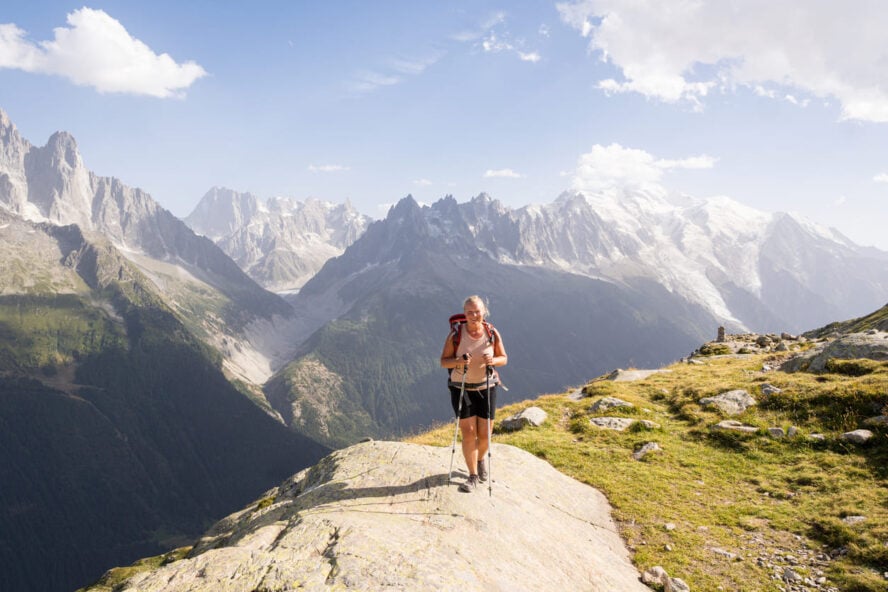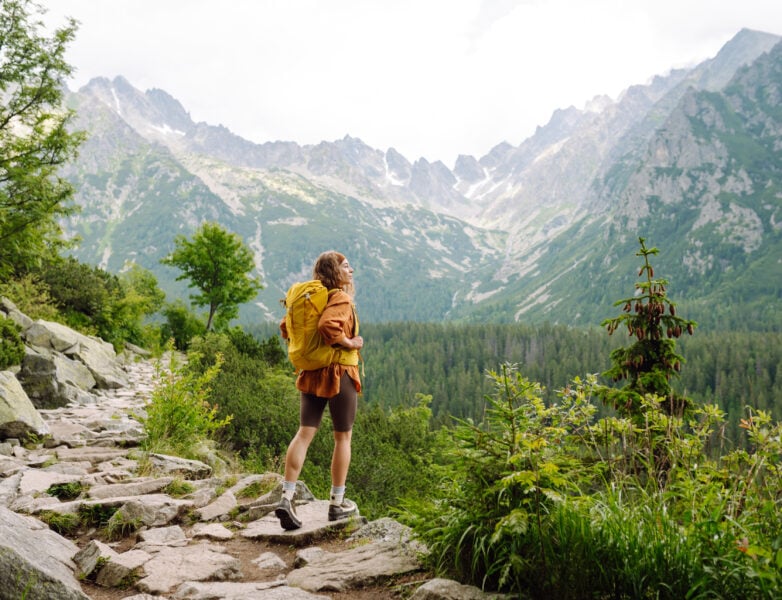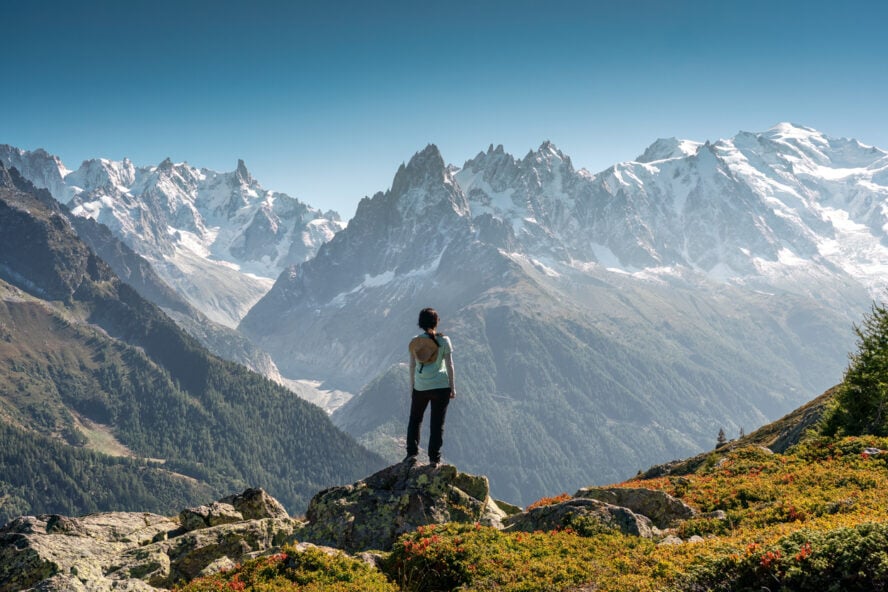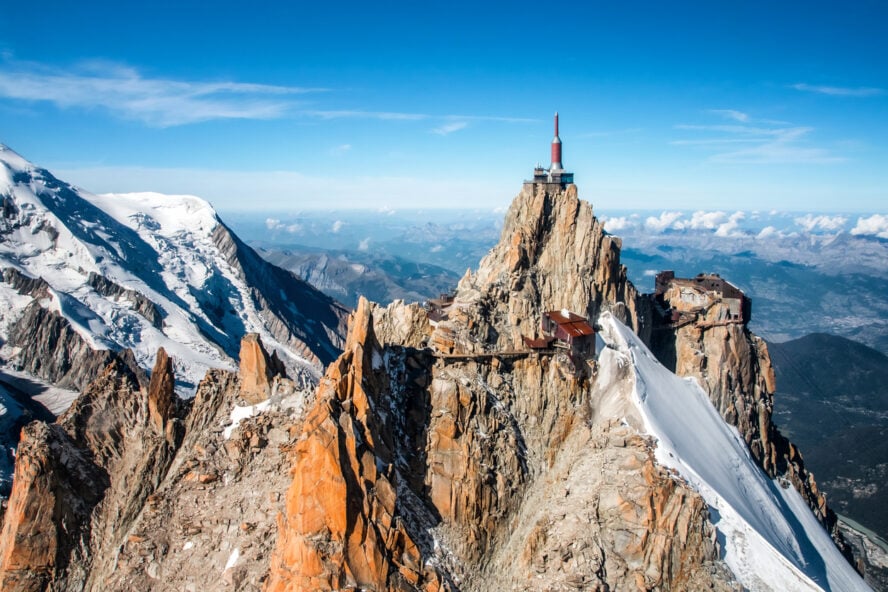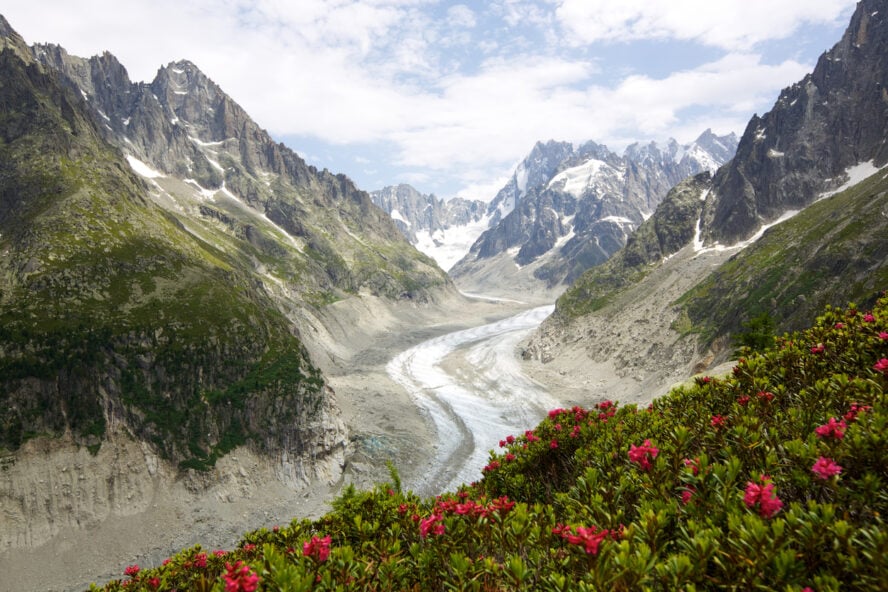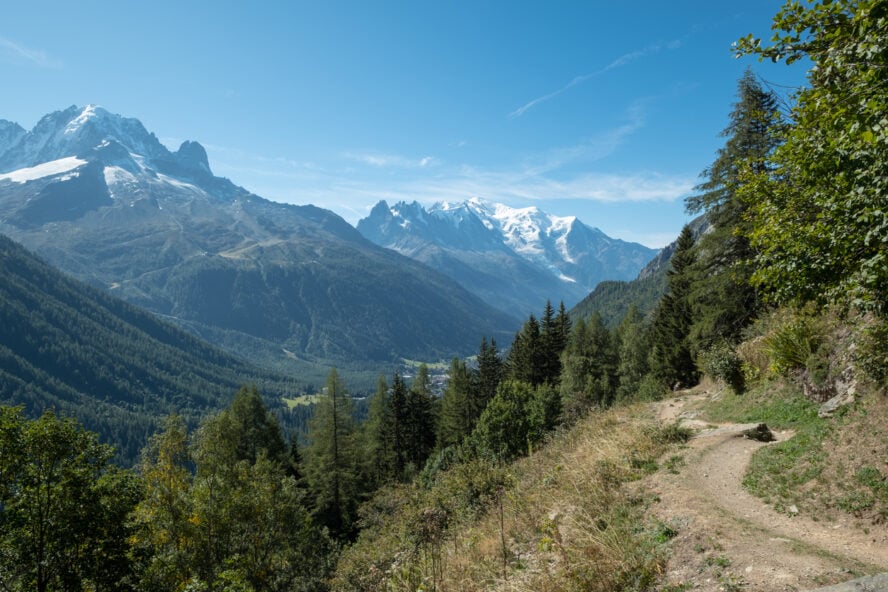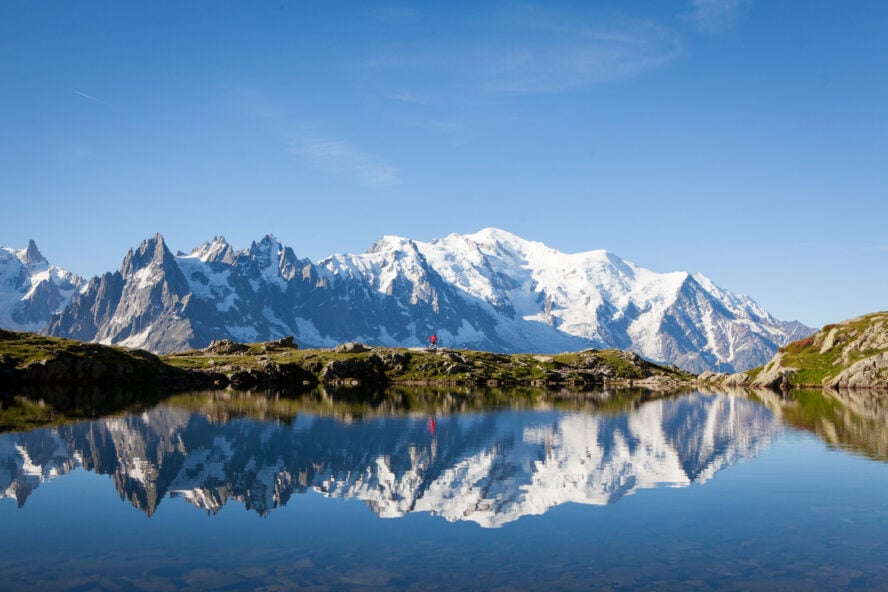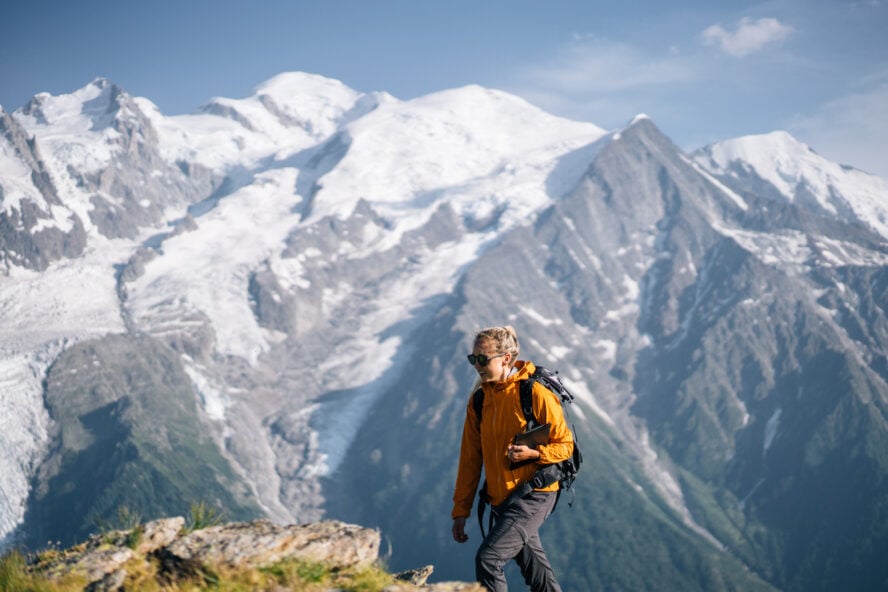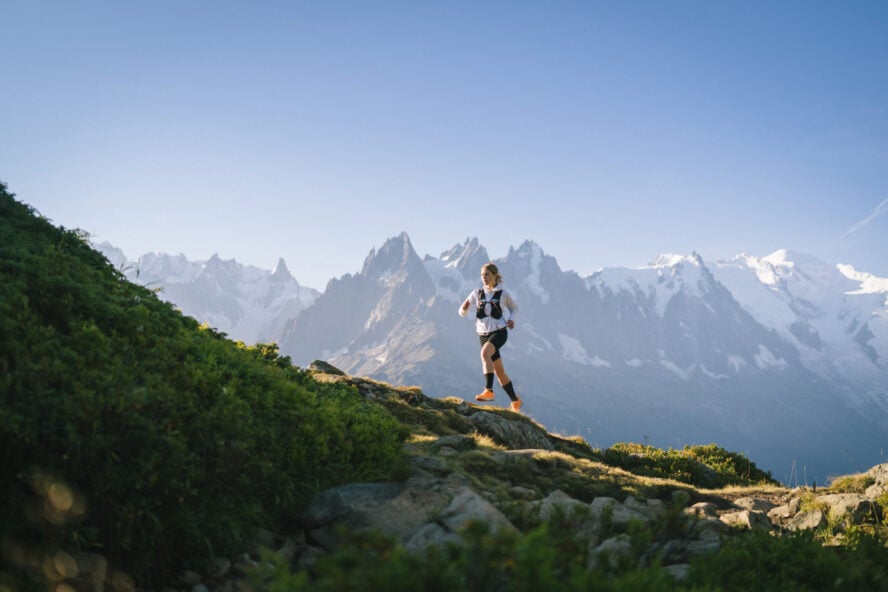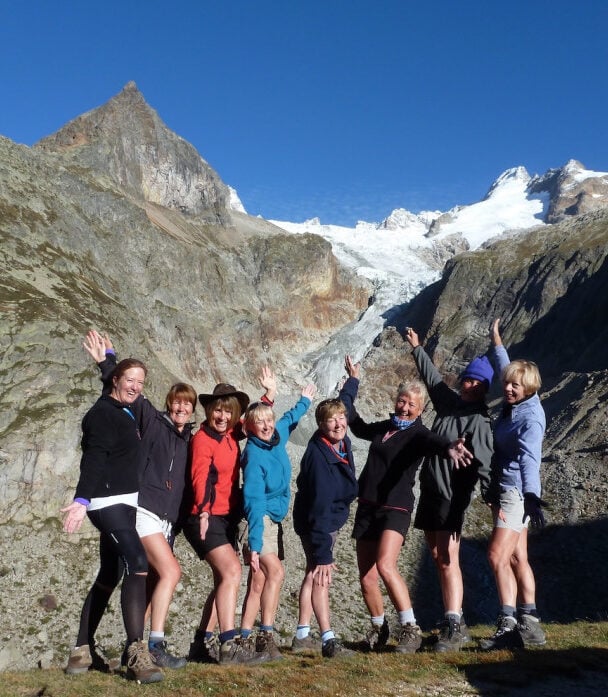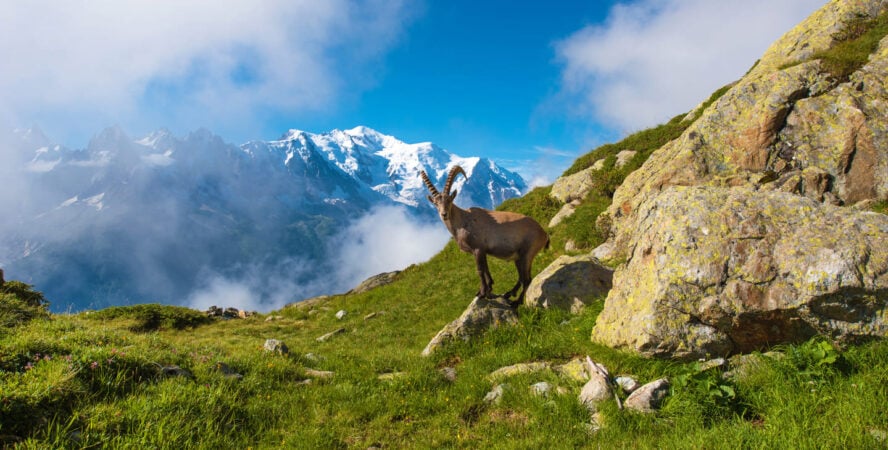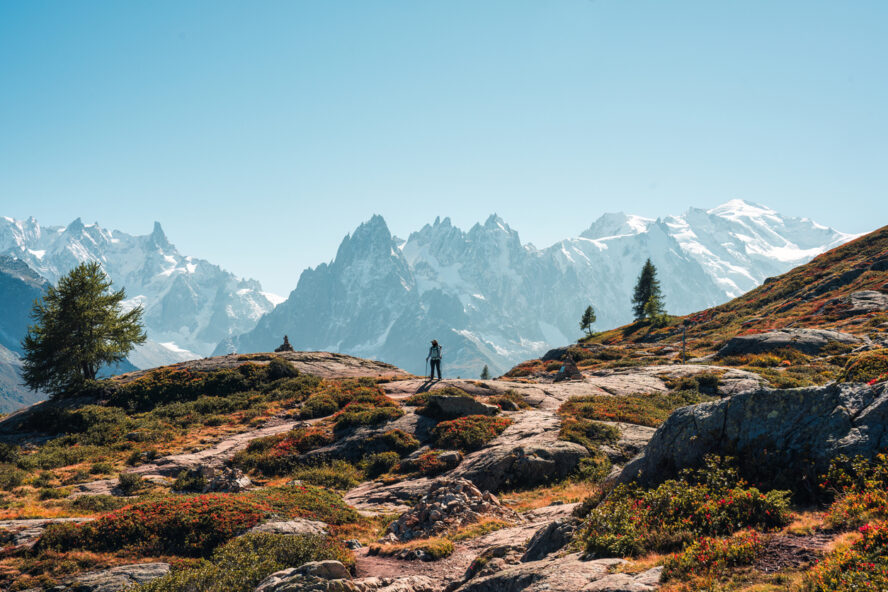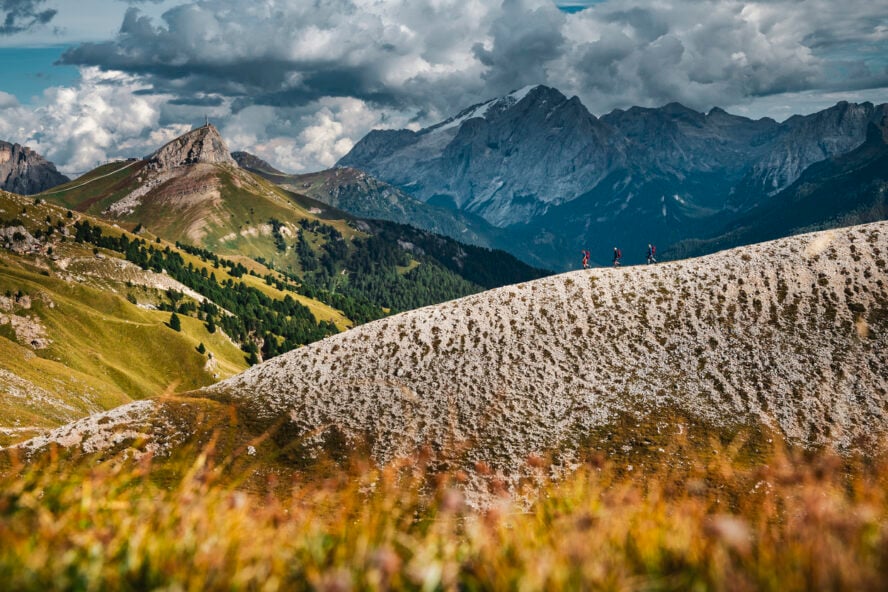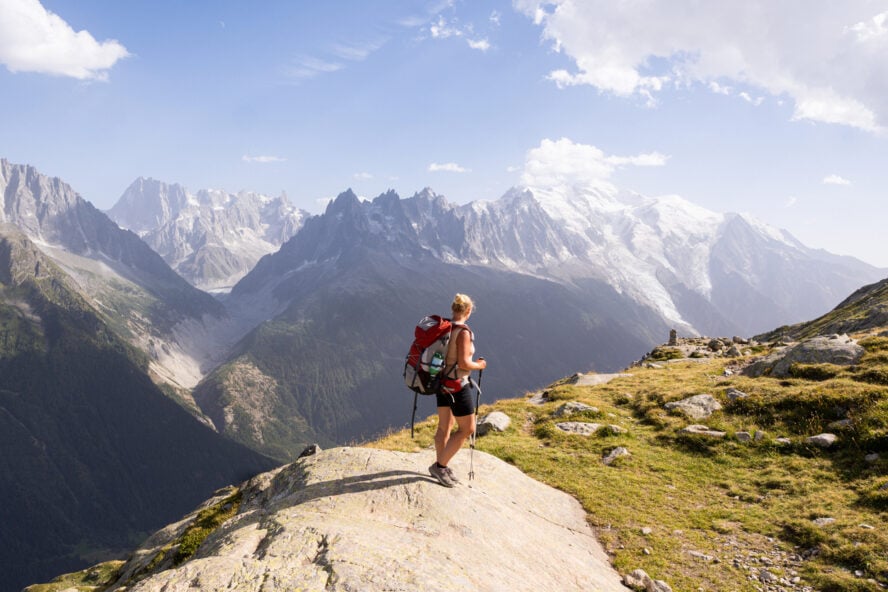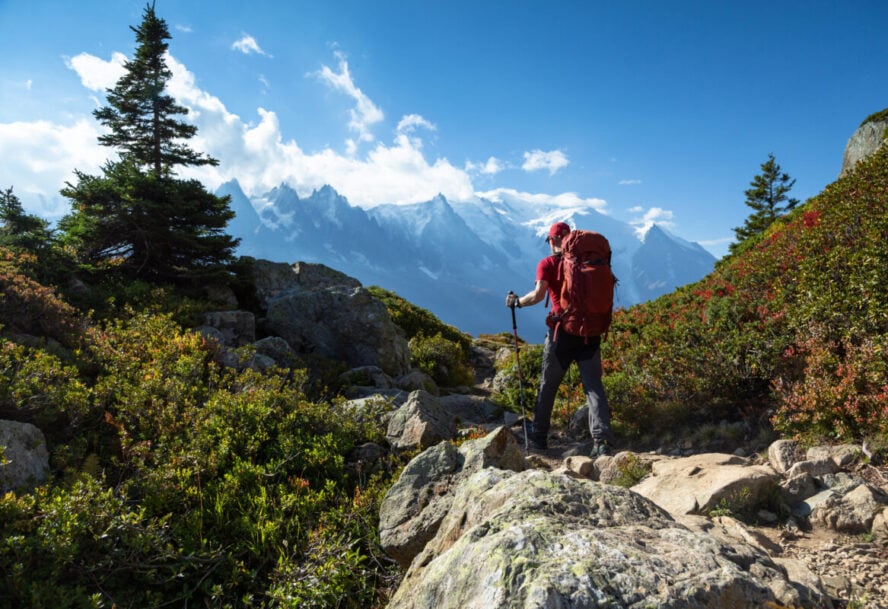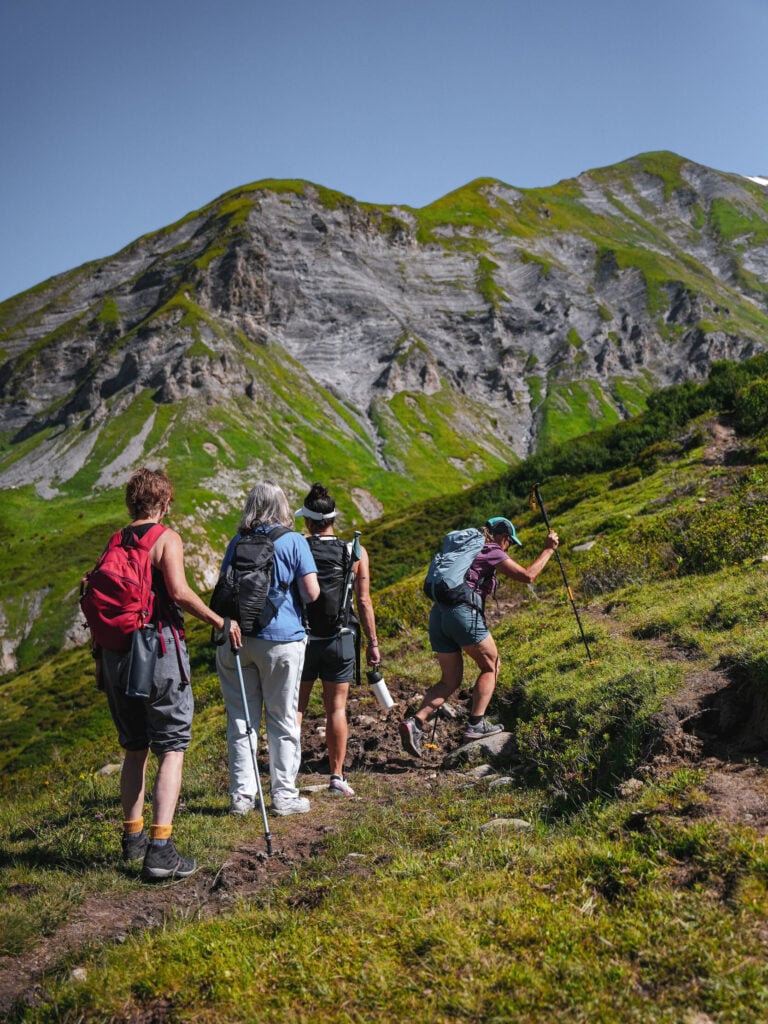I can’t say it enough: the Alps are pure magic.
No matter where you’re from or how many trails you’ve trekked, Mont Blanc’s rugged peaks and glacier-carved valleys will leave you speechless. Over a million adventurers flock to Chamonix each year, drawn to its dramatic landscapes.
But what makes this corner of France so irresistible? Towering spires, turquoise lakes, wildflower meadows, and glaciers that shimmer like nature’s jewels. These are the stuff of dreams.
So, you’re thinking of joining an all-women’s hiking adventure here. The big question: what’s the best way to experience Mont Blanc’s trails? The answer isn’t simple, but stick with me. I’m Marta Gil Sopena, your Chamonix-based guide, and I’ll share everything you need to plan an unforgettable journey.
Let’s hit the trail!
This article is based on Marta’s webinar on women’s hiking tours in the Mont Blanc area. Click here to check it out!
My Story: Why I Guide in Chamonix
I’m a qualified International Mountain Leader, and Chamonix has been my home since 2015.
I started hiking in the Pyrenees, but Mont Blanc stole my heart. The rugged peaks, shifting weather, and sense of freedom keep me here. I love guiding women, helping you build confidence and conquer trails together.
For me, Chamonix feels like an adventure every day. The beauty of the Alps, from glacier lakes to wildflower meadows, inspires me. I’ve led countless hikes here, and I’m excited to share my knowledge with you. I create trips that blend challenge and joy, perfect for women seeking empowerment in the mountains.
Why Mont Blanc? The Magic of Chamonix
Why hike Mont Blanc?
It’s a hiker’s paradise, nestled at the foot of Europe’s tallest mountain.
I live in Chamonix, a vibrant town with shops, restaurants, and unbeatable alpine vibes. The landscape is stunning: jagged spires, green valleys, and turquoise lakes. We had snow all May in 2025, but by July, trails burst with wildflowers. Ski season ends mid-April, though you can ski Aiguille du Midi into May.
Summer transforms Chamonix into a hiking haven. Some high trails, like those to Lac Blanc, hold snow into July, but most are clear by mid-summer.
Getting here is easy: fly into Geneva, just an hour away, or Lyon. Chamonix’s history as the 1924 Winter Olympics host adds a legacy of adventure. I can’t wait to show you why this place is so special!
The All-Women’s Hiking Experience
I love leading all-women’s hikes. They’re about empowerment and connection.
You’ll hike with a small group, up to eight women, creating a safe space to push your limits. I design these trips to foster camaraderie, whether you’re solo or with friends.
My programs are for women who want to explore, grow, and connect. We share laughs in meadows, cheer each other up climbs, and swap stories over dinner. My trips last five to seven days, with hikes tailored to different fitness levels.
They’re inclusive, welcoming all backgrounds, and focus on motivation, not competition. I’ve seen women light up hiking under Mont Blanc’s glaciers. I make sure every moment feels empowering and fun.
Best Hikes Around Mont Blanc
You all know the Tour du Mont Blanc hike, but there’s so much more to see in the area. I’ve picked my favorite Mont Blanc hikes for our all-women’s trips. Each shows off the Alps’ diversity, from glacier views to serene lakes.
They’re moderate, with four to seven hours of hiking and 400 to 800 meters or 1,312 to 2,625 feet of elevation gain. Short van rides, from 10 to 50 minutes, get us to the trails fast.
Here are some of the destinations I’ll guide you through.
Aiguille du Midi
This hike starts right from our hotel.
We walk one minute to the Aiguille du Midi cable car, which zips us to 3,842 meters or 12,605 feet. From there, we descend trails with stunning views of the Mont Blanc massif. I call it unforgettable.
The Bossons Glacier sparkles below. It’s a shorter day, about 8 kilometers or 5 miles, great for getting used to the altitude. My tip: go early for clear morning light on the peaks. We often pause to take in the panorama. I share stories of climbers here. This one feels like flying over the Alps.
The trail is accessible yet breathtaking. It’s perfect for bonding with the group early on.
Montenvers and Mer de Glace
I take you on a quick train ride to Montenvers, home to the Mer de Glace, France’s largest glacier.
We hike down to the ice cave or along trails with views of the Drus and Grandes Jorasses. The glacier has retreated 2 kilometers or 1.2 miles since the 1800s, which I find humbling.
The path is well-maintained, covering 7 kilometers or 4.3 miles. The 1908 Montenvers train adds a vintage touch. I love sharing this glacier’s story with my groups. We explore the ice formations up close. I point out wildlife along the way.
This hike mixes history and nature perfectly. It’s a chance to reflect on the Alps’ changing landscape.
Mountain Bears and Hidden Gems
I call my quieter trails “mountain bears” for their hidden charm.
A 40 to 50-minute drive takes us to serene valleys with chamois sightings. These 12-kilometer or 7.5-mile hikes feel off-the-beaten-path, with wildflower meadows and peaceful vibes. I choose these for our group to connect deeply with nature.
We wander through less crowded areas. I share tips on spotting eagles. This one lets us bond over the quiet beauty. It’s a refreshing change from busier spots. The trails offer a sense of discovery.
We often linger to soak in the solitude.
Lac Blanc and the Glacier Lakes
Lac Blanc in the Brevent-Flegere area is just a 10 to 15-minute drive from Chamonix.
We hike through pine forests to this turquoise lake, reflecting Mont Blanc’s glaciers. In July, wildflowers bloom everywhere. The trail mixes steady climbs with flat stretches, perfect for all paces. Snow patches linger early season, but by mid-summer, it’s clear.
We cover about 10 kilometers or 6.2 miles. I love picnicking here, soaking in views of the Aiguilles Rouges. It’s a highlight of our trip. The path offers chances to spot chamois grazing. I always point out the best photo spots.
We take breaks to marvel at the glacier reflections and the fir trees. The views of Mont Blanc are spectacular from this side of the valley. I like saving this one for the end of the trip, as it’s slightly more demanding than the other hikes.
Preparing for Your Hike
I want you ready to enjoy every step. Moderate fitness is enough for my hikes. I suggest training with four to seven-hour day hikes, carrying a 5 to 7-kilogram or 11 to 15-pound pack. Practice on hilly trails to prep for elevation gains of 400 to 800 meters or 1312 to 2625 feet.
Gear Essentials
I recommend a 20 to 30-liter backpack with comfy layers: a moisture-wicking base, fleece mid-layer, and waterproof shell.
Shorts are great for July’s 15 to 30 degrees Celsius or 59 to 86 degrees Fahrenheit, but pack pants for cloudy days. Sturdy hiking boots and trekking poles are musts.
Don’t forget sun protection: a big hat and SPF 50. I carry 2 liters of water and snacks like energy bars.
You can refill at streams if you have a filter. I’ll share a full gear list if you join my trip.
Prepping For The Weather
July and August mean warm days, 20 to 25 degrees Celsius or 68 to 77 degrees Fahrenheit, but storms can cool things to 15 degrees Celsius or 59 degrees Fahrenheit. I start early to dodge afternoon thunder.
September’s cooler but clearer. Check Meteo France daily. In 2025, late May snow might linger into July, so I pack extra layers.
Fitness and Altitude
Our highest point is about 2400 meters or 7,874 feet, which is manageable with a slow start.
My trips are designed to ease you into the altitude gradually. No crampons are needed after the ski season ends, so you can focus on enjoying the trails. I tailor these hikes for intermediate hikers, ensuring everyone feels confident and supported.
I recommend building endurance with weekly hikes, ideally on terrain with elevation changes to mimic the Alps. Practicing deep breathing techniques helps prepare for higher elevations. During our hikes, I keep a close eye on everyone for signs of altitude sickness, like headaches or dizziness.
We take regular breaks to acclimate, especially on the first couple of days. This approach keeps the experience enjoyable and safe for all. You can soak in the views without worry.
Where You’ll Stay and Eat
I base our trips out of 4-star hotels in Chamonix. You can choose a shared twin room or get a single room for an additional fee.
The breakfasts in these hotels are delicious and filling, with vegan options. We grab picnic lunches from the hotel, also vegan-friendly. The welcome dinner is included, but other dinners are your choice. I love exploring Chamonix’s restaurants, from fondue to pasta. Those will cost you around 20 to 40 euros, depending on the spot.
Planning Your Trip: Dates and Logistics
I guide these hikes from mid-June to September, when trails are mostly snow-free.
In 2025, expect trips in July, August, and September. Chamonix books up fast.
My trips run five to seven days, with short van rides: 10 minutes to Lac Blanc, 30 minutes through the Mont Blanc Tunnel, or 50 minutes to quieter trails. Want a private group of eight? I can arrange that, maybe at a different hotel. I plan a year ahead, so it’s best to book a year in advance to secure your spot.
Q&A: Your Burning Questions Answered
Can you hike Mont Blanc in shorts?
I hike in shorts most summer days, especially in July when temperatures hit 20 to 25 degrees Celsius or 68 to 77 degrees Fahrenheit.
The warmth feels perfect for these moderate trails, and I notice many women in my groups prefer shorts too for comfort and breathability.
That said, I always pack lightweight pants as a backup for cloudy days or sudden temperature drops, which can dip to 15 degrees Celsius or 59 degrees Fahrenheit. Sun protection is crucial when wearing shorts. Bring big hats and SPF 50 to shield against the intense alpine UV.
I also recommend knee-high socks to protect against scratches on rocky paths. Shorts let you move freely, but layering smartly keeps you ready for anything.
Where Do Most Of My Hikers Come From?
My groups are wonderfully diverse, with women joining from the US, UK, and various European countries. I love this global mix. It makes every hike a cultural exchange.
You’ll hear stories from different corners of the world as we trek, from New Yorkers sharing city adventures to Brits recounting their Lake District hikes. This diversity adds such richness to our trips. We bond over shared meals and trail challenges, creating friendships that often last beyond the Alps.
It’s one of my favorite parts of guiding: seeing women from all walks of life connect over a love for the mountains. You’ll feel right at home, no matter where you’re from.
What’s The Best Month to Hike In The Mont Blanc Area?
Choosing the best month is tough because each has its charm, but I’ll break it down.
July is my personal favorite. The wildflowers are in full bloom, carpeting meadows with vibrant colors like purples, yellows, and whites. The trails feel alive and lush.
August brings the warmest weather, often steady at 20 to 25 degrees Celsius or 68 to 77 degrees Fahrenheit. Perfect for longer hiking days and clear glacier views.
September offers quieter trails with fewer crowds and a golden light that makes the Alps glow.
Each month has unique perks: July’s floral spectacle, August’s reliable warmth, or September’s peaceful solitude. I’d pick July for its blooming energy, but you can’t go wrong with any of them.
What’s The Highest Point We Will Hike To?
The highest point we reach is about 2400 meters or 7874 feet, usually on trails like Lac Blanc.
It’s very manageable with my gradual itinerary, designed to ease you into the altitude. I start with gentler hikes to help your body adjust, especially since we’re coming from Chamonix’s base at around 1000 meters or 3281 feet.
I keep a close eye on everyone for signs of altitude sickness, like headaches or fatigue, and we take plenty of breaks to catch our breath and enjoy the views. Most women find it comfortable with this approach.
Proper hydration and slow pacing make all the difference. You’ll feel strong and ready for the stunning vistas at the top.
Oh, the Thrill of Alpine Choices!
I hope I’ve made planning your Mont Blanc adventure a bit easier.
Organizing a big trip like this can feel overwhelming, especially with so much conflicting advice online. When choosing how to hike Mont Blanc, think about your budget, schedule, and the experiences you’re craving—whether it’s wildflower meadows, glacier views, or quiet trails.
No matter your age, experience, or fitness level, Chamonix’s trails offer wonders to fill your heart year-round. That’s all from me. Thanks for reading, and happy hiking!


